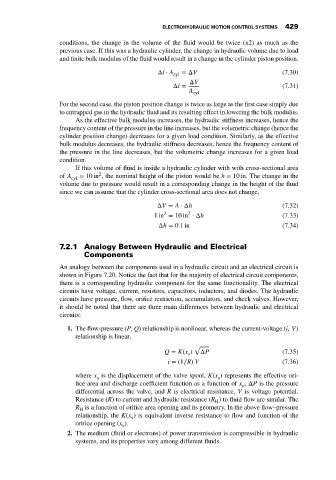Page 443 - Mechatronics with Experiments
P. 443
Printer: Yet to Come
October 9, 2014 8:41 254mm×178mm
JWST499-c07
JWST499-Cetinkunt
ELECTROHYDRAULIC MOTION CONTROL SYSTEMS 429
conditions, the change in the volume of the fluid would be twice (x2) as much as the
previous case. If this was a hydraulic cylinder, the change in hydraulic volume due to load
and finite bulk modulus of the fluid would result in a change in the cylinder piston position.
Δl ⋅ A cyl =ΔV (7.30)
ΔV
Δl = (7.31)
A cyl
For the second case, the piston position change is twice as large as the first case simply due
to entrapped gas in the hydraulic fluid and its resulting effect in lowering the bulk modulus.
As the effective bulk modulus increases, the hydraulic stiffness increases, hence the
frequency content of the pressure in the line increases, but the volumetric change (hence the
cylinder position change) decreases for a given load condition. Similarly, as the effective
bulk modulus decreases, the hydraulic stiffness decreases, hence the frequency content of
the pressure in the line decreases, but the volumetric change increases for a given load
condition.
If this volume of fluid is inside a hydraulic cylinder with with cross-sectional area
2
of A cyl = 10 in , the nominal height of the piston would be h = 10 in. The change in the
volume due to pressure would result in a corresponding change in the height of the fluid
since we can assume that the cylinder cross-sectional area does not change,
ΔV = A ⋅ Δh (7.32)
2
3
1in = 10 in ⋅ Δh (7.33)
Δh = 0.1 in (7.34)
7.2.1 Analogy Between Hydraulic and Electrical
Components
An analogy between the components used in a hydraulic circuit and an electrical circuit is
shown in Figure 7.20. Notice the fact that for the majority of electrical circuit components,
there is a corresponding hydraulic component for the same functionality. The electrical
circuits have voltage, current, resistors, capacitors, inductors, and diodes. The hydraulic
circuits have pressure, flow, orifice restriction, accumulators, and check valves. However,
it should be noted that there are three main differences between hydraulic and electrical
circuits:
1. The flow-pressure (P, Q) relationship is nonlinear, whereas the current-voltage (i, V)
relationship is linear,
√
Q = K(x ) ΔP (7.35)
s
i = (1∕R) V (7.36)
where x is the displacement of the valve spool, K(x ) represents the effective ori-
s s
fice area and discharge coefficient function as a function of x , ΔP is the pressure
s
differential across the valve, and R is electrical resistance, V is voltage potential.
Resistance (R) to current and hydraulic resistance (R ) to fluid flow are similar. The
H
R is a function of orifice area opening and its geometry. In the above flow–pressure
H
relationship, the K(x ) is equivalent inverse resistance to flow and function of the
s
orifice opening (x ).
s
2. The medium (fluid or electrons) of power transmission is compressible in hydraulic
systems, and its properties vary among different fluids.

